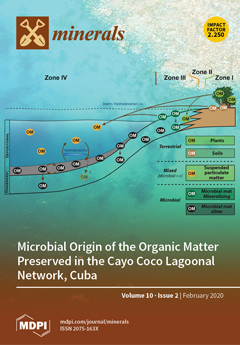Volcanic rocks, as the extrusive counterparts of the mineralized intrusions, can provide important information on the magma source, petrogenesis, and metallogenic conditions of the coeval porphyry-epithermal system. Shanghang Basin volcanic rocks are spatially and temporally related to a series of adjacent porphyry-epithermal Cu–Au
[...] Read more.
Volcanic rocks, as the extrusive counterparts of the mineralized intrusions, can provide important information on the magma source, petrogenesis, and metallogenic conditions of the coeval porphyry-epithermal system. Shanghang Basin volcanic rocks are spatially and temporally related to a series of adjacent porphyry-epithermal Cu–Au deposits, and they can be used as a window to study the related deposits. Two laser-ablation–inductively coupled plasma–mass spectrometry zircon U–Pb analyses of the volcanic rocks yield weighted mean ages of ~105 Ma, identical to the age of the coeval porphyry-epithermal mineralization. Rocks have SiO
2 contents of 55.4 to 74.8 wt % and belong to the high-K to shoshonitic series, characterized by strong differentiation of light rare-earth elements (REEs) relative to heavy REEs (mean La
N/Yb
N = 16.88); enrichment in light REEs, Rb, Th, and U; and depletion in Nb, Ta, Zr, Hf, and Ti. The volcanic rocks display (
87Sr/
86Sr)
i values of 0.709341 to 0.711610, ε
Nd(t) values of −6.9 to −3.3 ε
Hf(t) values of −3.95 to −0.30, and δ
18O values of 6.07‰–6.79‰, suggesting that the parental magmas were derived from a mantle source enriched by subduction-related progress. SiO
2 content shows a strong negative correlation with the contents of some major and trace elements, indicating that fractional crystallization played an important role in the generation of these rocks. A binary mixing model of Hf–O isotopes gives an estimated degree of crustal contamination of 30%. In addition, magnetite crystallized early, and the samples showed high zircon Eu
N/Eu
N* values (0.48–0.68), indicating that the parental magma had a high oxygen fugacity. The inferred suppression of plagioclase crystallization and increasing hornblende crystallization during magma evolution suggest that the magma was water rich. The high-water content and high oxygen fugacity of the magma promoted the dissolving of sulfides containing Cu and Au in the source area and contributed to the migration of ore-forming elements.
Full article





